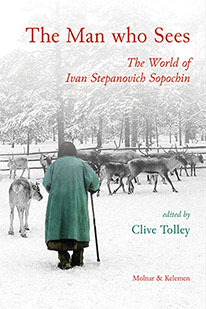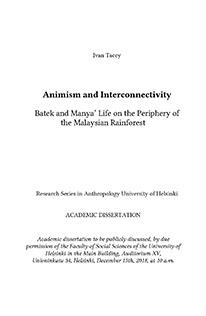
Tolley, Clive (ed.) The Man who Sees: Ivan Stepanovich Sopochin.
Studies in Native Religion 2. Budapest: Molnar & Kelemen, 2021.
Ivan Stepanovich Sopochin lived his whole life following the traditional customs of his people, one of the branches of the
Eastern Khanty, on a tributary of the Ob′, the Woki-rap-yagun (‘Fox-cliff river’), near Surgut. He remained a monolingual
speaker of his dialect, and was a guardian of spiritual traditions. In his youth he was arrested for the practice of
shamanism – though he called himself not a shaman, but a ‘man who sees’, who has visions. In the last years of his life
(he died in 1993), he attracted many visits from researchers into shamanism and traditional culture. The present volume
presents the research of some of the scholars who carried out field work or have studied Sopochin’s spiritual traditions,
and marks a significant contribution to English-language research into Eastern Khanty shamanism and traditional culture.
This volume is available as an open-access digital file. Please click here to download from the University of Turku website.

Riboli, Diana. Consciousness and Indigenous Healing Systems: Between Indigenous Perceptions and Neuroscience. New York: Nova Publishers, 2014.
After decades of discussion in different scientific fields, the concept of consciousness is still very elusive. This book aims to define actual perceptions of consciousness in various indigenous cultures using seminal anthropological case studies as well as material from research conducted by the author in Nepal and Peninsular Malaysia. The purpose is to show the impressive similarities between indigenous perceptions of consciousness and neuroscientific theories (Imprint: Nova)
This volume is available as an open-access digital file. Please click here to download from the publishers website.

Tacey, Ivan. Animism and Interconnectivity : Batek and Manya’ Life on the Periphery of the Malaysian Rainforest.
Research Series in Anthropology, Academic Dissertation. University of Helsinki, 2018.
Animism and Interconnectivity is an ethnographic study of Batek Dè’ and Manya’ religion on the periphery of the Malaysian rainforest. In the twenty-first century, the lives of these two small-scale groups of former hunter-gatherers take place on the interconnected frontier between forest and the outside world, a nexus of different ideas, peoples and objects of diverse origins. Contesting views of animism as an objectified and timeless ontology, the study adopts a politicizing and historicizing approach. It explores how political marginalization, rapid environmental change and historical conditions of subordination and violence have shaped changes and continuities in shamanistic practices, myths, cosmologies and relations with other-than-human beings. Through an examination of specific events in particular places on the forest periphery, it highlights the many qualities and shades of interconnection to show the depth and breadth of its impact on animistic forms and practices.
This volume is available as an open-access digital file. Please click here to download from the University of Helsinki website.
